International Round-Table Conference on Environmental History
On May, 13th the National Research University-Higher School of Economics at St. Petersburg hosted the international round table on environmental history, organized by SESL and the Department of Humanities.
On May, 13th the National Research University-Higher School of Economics at St. Petersburg hosted the international round table on environmental history, organized by SESL and the Department of Humanities.
The round table brought together interesting and very diverse audience: teachers, researchers and students of different departments: historians, historical geographers, archaeologists, historians of science, environmentalists. There were people working in museums and foreign graduates – the trainees of the European University in St. Petersburg.
The meeting was opened by the director of Environmental and technological history centre of the European University in St. Petersburg and a senior researcher of the HSE in St. Petersburg, Julia Layus. She briefly spoke about the main areas of environmental history and the activities of the Centre. Environmental history is the history of the relationship between man and nature. Its purpose, as defined by president of the American Society for Environmental History John McNeil, is to serve humanity by providing it with knowledge of the past that can be used for building the future. Environmental historians reveal the historical causes of modern ecological problems by considering connection between nature, economics as a way to interact with nature, and images of nature in human consciousness.
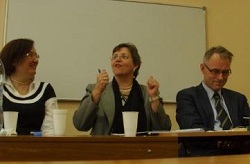 One of the founders of the European Society for Environmental History (ESEH) and its past president Verena Winiwarter, professor and dean of the Department of Interdisciplinary Studies, University of Klagenfurt (Vienna, Austria), vividly spoke about the history of the Society, founded in 1999. Her participation in the conference of the American Society for Environmental History (ASEH) became the impetus for the organization of the Society. Three days spent at the conference were a turning point both in her academic career and in the fate of environmental history in Europe. After talking with American historians it became clear that environmental history is not a marginal boring lesson in the history of a local nature consumption in one of the Alpine villages, but a new rapidly developing scientific school that can combine local and global approaches to understanding the role of nature in the history of mankind. Encouraged by the example of American historians, Verena Winivarter managed to gather a small group of European historians who share the same ideas and created the European Society for Environmental History. Since the very beginning of its existence, the Society has aimed to involve historians from Eastern Europe and Russia. That’s why no wonder that Verena Winivarter suggested the Danube Environmental History Initiative (DEHI) to study the river running through much of Eastern Europe.
One of the founders of the European Society for Environmental History (ESEH) and its past president Verena Winiwarter, professor and dean of the Department of Interdisciplinary Studies, University of Klagenfurt (Vienna, Austria), vividly spoke about the history of the Society, founded in 1999. Her participation in the conference of the American Society for Environmental History (ASEH) became the impetus for the organization of the Society. Three days spent at the conference were a turning point both in her academic career and in the fate of environmental history in Europe. After talking with American historians it became clear that environmental history is not a marginal boring lesson in the history of a local nature consumption in one of the Alpine villages, but a new rapidly developing scientific school that can combine local and global approaches to understanding the role of nature in the history of mankind. Encouraged by the example of American historians, Verena Winivarter managed to gather a small group of European historians who share the same ideas and created the European Society for Environmental History. Since the very beginning of its existence, the Society has aimed to involve historians from Eastern Europe and Russia. That’s why no wonder that Verena Winivarter suggested the Danube Environmental History Initiative (DEHI) to study the river running through much of Eastern Europe.
Verena Winivarter illustrated the complexity of management of nature, as well as management of scientific research, with the help of the examples from her specialty – medieval environmental history. Venetian Republic needed good wood for building ships, so special attention was paid to the protection of oak plantations – it was not allowed to cut trees and even to gather brushwood. Other trees and shrubs that grew on the plantation were mercilessly destroyed. When a hundred years later the result was estimated, it turned out that oaks grew very poorly. The protection was improved. One hundred years later the result was even more disappointing ... And it is not surprising because with no other trees around, they could not grow to the needed size. The reason for failure was lack of understanding of the complex interconnection in the ecosystem and straightforward ideas that only with reliable security we can have giant oaks on the protected area.
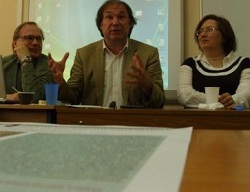 Professor Christof Mauch, the director of the Rachel Carson Center for Environment and Society (RCC), opened in 2010 in Munich, spoke about the power of images of nature and people's ideas about nature. He illustrated it with the examples of three U.S. sites located close to each other that looked the same one hundred and fifty years ago. Currently, the identity of the first one is built around the park of dinosaurs, created in this area because in this very place paleontologists have made remarkable discoveries. The identity of the second site is built around oil production, that completely changed the surrounding landscape, while in the third site people managed to save the forest reserve, as there President Theodore Roosevelt liked to hunt. Then Christof Mauch spoke about how the power of the “silent spring” image, created in 1962 by Rachel Carson, an American biologist and writer. It is the spring, when no birds sing because they were killed by the poisonous insecticide DDT. This image changed the consciousness of millions of people and caused a mass movement to protect the environment. The name Rachel Carson was given to the Centre in Munich, which provides scholarships on environmental history to scientists around the world in order to emphasize its international character and to promote the study of history of relationship between man and nature for a more harmonious development in the future.
Professor Christof Mauch, the director of the Rachel Carson Center for Environment and Society (RCC), opened in 2010 in Munich, spoke about the power of images of nature and people's ideas about nature. He illustrated it with the examples of three U.S. sites located close to each other that looked the same one hundred and fifty years ago. Currently, the identity of the first one is built around the park of dinosaurs, created in this area because in this very place paleontologists have made remarkable discoveries. The identity of the second site is built around oil production, that completely changed the surrounding landscape, while in the third site people managed to save the forest reserve, as there President Theodore Roosevelt liked to hunt. Then Christof Mauch spoke about how the power of the “silent spring” image, created in 1962 by Rachel Carson, an American biologist and writer. It is the spring, when no birds sing because they were killed by the poisonous insecticide DDT. This image changed the consciousness of millions of people and caused a mass movement to protect the environment. The name Rachel Carson was given to the Centre in Munich, which provides scholarships on environmental history to scientists around the world in order to emphasize its international character and to promote the study of history of relationship between man and nature for a more harmonious development in the future.
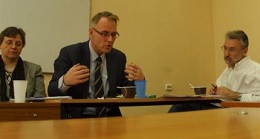 “The humanities are currently experiencing a deep crisis”, – stressed Sverker Sorlin, professor of environmental history of the Royal Institute of Technology in Stockholm. The crisis of the humanities is directly related to the crisis of the idea of the ethnic state, which served as the basis for the development of the humanities in the past. In this regard, Sverker Sorlin believes that the humanities must participate in solving global problems, such as the clash of religions or the problem of preserving the environment. He proposed to take an example from natural scientists who easier join their efforts and create centers for contemporary issues research and to cooperate with them. For example, he, being the only humanist among ecologists and geographers, participated in the creation of the Stockholm Resilience Centre in 2007, which is known for interdisciplinary studies of social-ecological systems in the light of the theory of “resistance” – system's ability to evolve and develop.
“The humanities are currently experiencing a deep crisis”, – stressed Sverker Sorlin, professor of environmental history of the Royal Institute of Technology in Stockholm. The crisis of the humanities is directly related to the crisis of the idea of the ethnic state, which served as the basis for the development of the humanities in the past. In this regard, Sverker Sorlin believes that the humanities must participate in solving global problems, such as the clash of religions or the problem of preserving the environment. He proposed to take an example from natural scientists who easier join their efforts and create centers for contemporary issues research and to cooperate with them. For example, he, being the only humanist among ecologists and geographers, participated in the creation of the Stockholm Resilience Centre in 2007, which is known for interdisciplinary studies of social-ecological systems in the light of the theory of “resistance” – system's ability to evolve and develop.
Adrian Selin, professor of humanities in the HSE, St. Petersburg, spoke about the status of Russian research in the field of historical geography, which is mainly local. The main area of historical and geographical research is the localization of objects in space, which is known from written sources. It’s important to study objects such as roads that appeared in the Late Middle Ages and survived in modern space and folk tradition. Their origin is dual: roads are traces of the internal colonization, and the result of activity of the state, penetrating into the traditional agricultural landscape. For example, in 1602, the government organized massive work on building a road from Ivangorod to Moscow, on which a Danish prince Johan was supposed to travel to the wedding with Xenia Godunova. The building had a huge impact on local rural communities, that worked on its building. Soon the road was abandoned, but to this day it remains an object of the landscape, and unlike other roads connecting villages, is present in the modern folk tradition. The example shows that the study of man's penetration in nature in Russian context, should take into account its important characteristic feature: the role of the state.
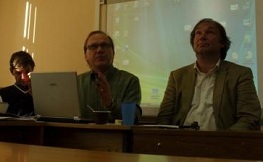 Timo Myllyntaus, professor in the University of Turku, presented an optimistic picture of ecological history in Finland. Despite the fact that in this country there is neither research center, nor professorial position on environmental history, Finnish historians pay much attention to the description of the relationship between man and nature in the past, and not only in Finland. They write works on the environmental history of Africa, Latin America, the United States. Timo Myllyntaus emphasized the close connection between environmental and technological history, because people have always, even in the most ancient times, interacted with nature through technology – agricultural, mining, industrial.
Timo Myllyntaus, professor in the University of Turku, presented an optimistic picture of ecological history in Finland. Despite the fact that in this country there is neither research center, nor professorial position on environmental history, Finnish historians pay much attention to the description of the relationship between man and nature in the past, and not only in Finland. They write works on the environmental history of Africa, Latin America, the United States. Timo Myllyntaus emphasized the close connection between environmental and technological history, because people have always, even in the most ancient times, interacted with nature through technology – agricultural, mining, industrial.
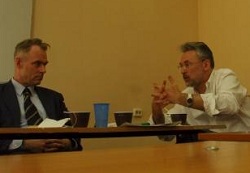 Daniel Alexandrov ended the round-table conference, outlining those scientific areas which environmental historians may interact with to develop their region. Historians, he said, are very conservative and resist the emergence of new sub-disciplines of historical science. At first he spoke about the successful experience of cooperation with environmentalists in the research on the historical ecology of fish and sea animals, which evolved for 10 years in the founded by him in 2001, the Center for Environmental and technological history in the European University, St. Petersburg. Then he suggested the possible fruitful cooperation with archaeologists and historical geographers. Cooperation with local museums in the study of the industrial history of small Russian towns, in which the impact of industry on the landscape and environment was significant, may become an important prospect for the emergence of environmental and technological history in Russia. Provincial archives are full of wonderful materials of this kind. Then Daniel Alexandrov highlighted the need for international cooperation, joint European programs on environmental history. He also raised a question of the necessity of teaching technological history to Russian students –engineers, as it is done, for example, in the Royal Institute of Technology in Stockholm. He also said that the leaders of the most prominent technical colleges are beginning to understand the need for the humanization of engineering education. At the end of his speech, Daniel Alexandrov reminded the audience the story told by Verena Vinivarter about growing oaks and said that he hoped we would not have to spend a century on experiments in the field of teaching and that he was sure of good prospects for the development of environmental history in Russia not only as a research but also as an academic discipline.
Daniel Alexandrov ended the round-table conference, outlining those scientific areas which environmental historians may interact with to develop their region. Historians, he said, are very conservative and resist the emergence of new sub-disciplines of historical science. At first he spoke about the successful experience of cooperation with environmentalists in the research on the historical ecology of fish and sea animals, which evolved for 10 years in the founded by him in 2001, the Center for Environmental and technological history in the European University, St. Petersburg. Then he suggested the possible fruitful cooperation with archaeologists and historical geographers. Cooperation with local museums in the study of the industrial history of small Russian towns, in which the impact of industry on the landscape and environment was significant, may become an important prospect for the emergence of environmental and technological history in Russia. Provincial archives are full of wonderful materials of this kind. Then Daniel Alexandrov highlighted the need for international cooperation, joint European programs on environmental history. He also raised a question of the necessity of teaching technological history to Russian students –engineers, as it is done, for example, in the Royal Institute of Technology in Stockholm. He also said that the leaders of the most prominent technical colleges are beginning to understand the need for the humanization of engineering education. At the end of his speech, Daniel Alexandrov reminded the audience the story told by Verena Vinivarter about growing oaks and said that he hoped we would not have to spend a century on experiments in the field of teaching and that he was sure of good prospects for the development of environmental history in Russia not only as a research but also as an academic discipline.
by Julia Layus

